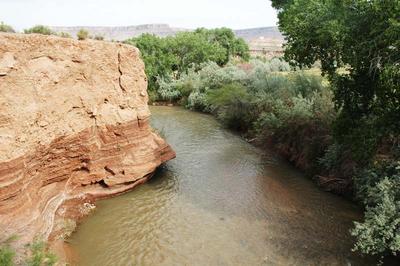|
PROCEDURE
[Features] [Main Page] [Sample input] [Rationale] Column 1: Size fraction range in mm. The normal list has one (1) fine (silt and clay) and eight (8) coarse (sand and gravel) = nine (9) size fraction ranges. The long list has two (2) fine (silt and clay) and eight (8) coarse (sand and gravel) = ten (10) size fraction ranges. Column 2: Geometric mean [of the size fraction range limits] D (mm). Column 3: Geometric mean [of the size fraction range limits] D (ft). Column 4: The intensity of shear: ψ = the largest of either
The sampled (measured) suspended load: Qsm = 0.0027 C Q (in tons/day, or T/D) Ks = D65 Assume x = 1.54 (SR)1/2 = u / [32.63 log10(12.27 x d/Ks)] The shear velocity: u'* = (gRS)1/2 The kinematic viscosity ν is a function of temperature t (Plate 2, with minor corrections). The thickness of the laminar sublayer: δ = 11.6 ν / u'* Given Ks / δ, use Plate 3 to find new value of x. Recalculate if different from the assumed value. P = 2.303 log10 (30.2 x d / Ks) A' = dn / ds With P and A', use Plate 4 to find the percentage of flow in sampled zone. The sediment discharge through the sampled zone: Q's Total = (percentage of flow in sampled zone) * Qsm
Column 5: Given ψ, use Plate 5 to calculate the intensity of bed-load transport (φ*/2) Column 6: 1,200 D3/2 Column 7: fraction of bed material ib (input array data) Column 8: ibqb = 1,200 D3/2 ib (φ*/2) = [Col. 6] [Col 7] [Col.5] Column 9: 43.2 w Column 10: iBQB = (43.2 w) (ibqb) = [Col. 9] [Col. 8] Column 11: percentage of suspended material Q's in each size fraction (input array data) Column 12: [Col. 11] (Q's Total) Column 13: Multipliers, or ratios of the 0.7 power of the fall velocities with the reference size. The reference size is chosen as one of the suspended size fractions containing a substantial amount [the larger percentage] of the sampled load. By definition, the multiplier for the reference size is 1. Column 14: First, compute Z' for the reference size by trial and error. Given Q's / iBQB, use Plate 8 to find an initial value of Z'. LHS = Q's / iBQB Calculate RHS = (I"1 / J"1) (P J'1 + J'2) With Z' and A" (Col. 15), use Plate 9 to find I"1 With Z' and A" (Col. 15), use Plate 10 to find J"1 With Z' and A', use Plate 10 to find J'1 With Z' and A', use Plate 11 to find J'2 Iterate on Z' until LHS = RHS. Finally, use multipliers in Col. 13 to calculate Z' for other size fractions, i.e., Col. 14. Column 15: A" = 2D / d = 2 (Col. 3) / d Column 16: With Z' and A', use Plate 10 to find J'1 Column 17: With Z' and A', use Plate 11 to find J'2 Column 18: With Z' and A", use Plate 10 to find J"1 Column 19: With Z' and A", use Plate 11 to find J"2 Column 20: [ P (Col. 18) - (Col. 19) ] [ P (Col. 16) - (Col. 17) ] Column 21: With Z' and A", use Plate 9 to find I"1 Column 22: With Z' and A", use Plate 12 to find I"2 Column 23: [ P (Col. 21) - (Col. 22) + 1 ] Column 24: Either a. For finer particle sizes: (Col. 12) (Col. 20). or b. For coarser particle sizes: (Col. 10) (Col. 23). Column 25: [For SI units only] Computed load in Metric Tons/day = (Col. 24) * 0.9072 |
